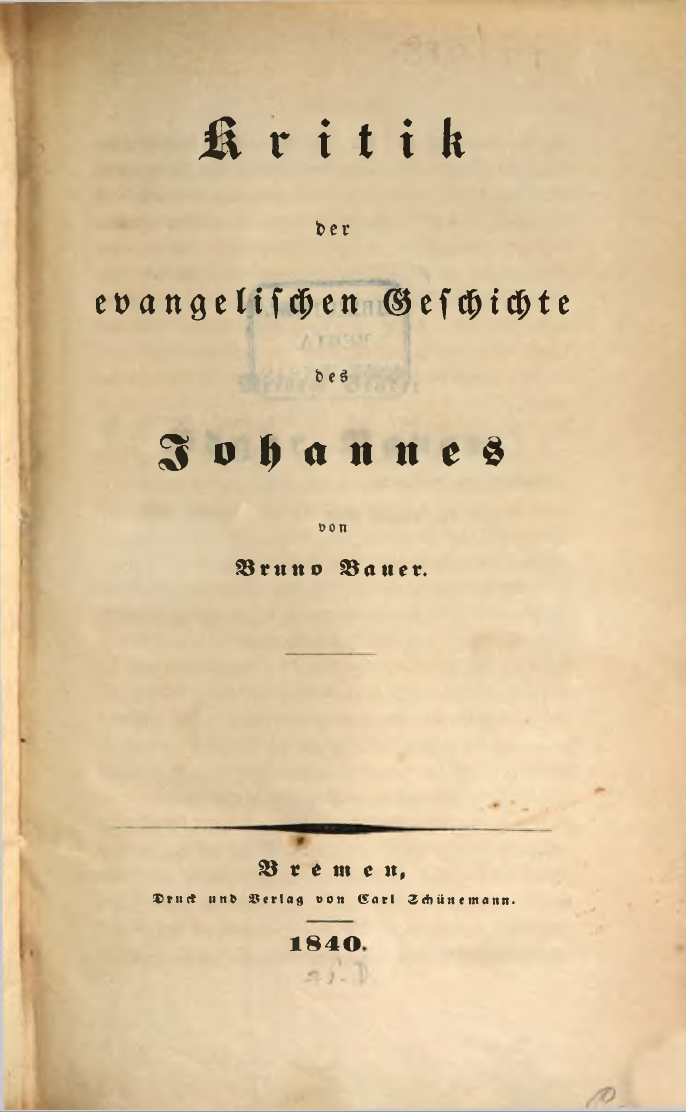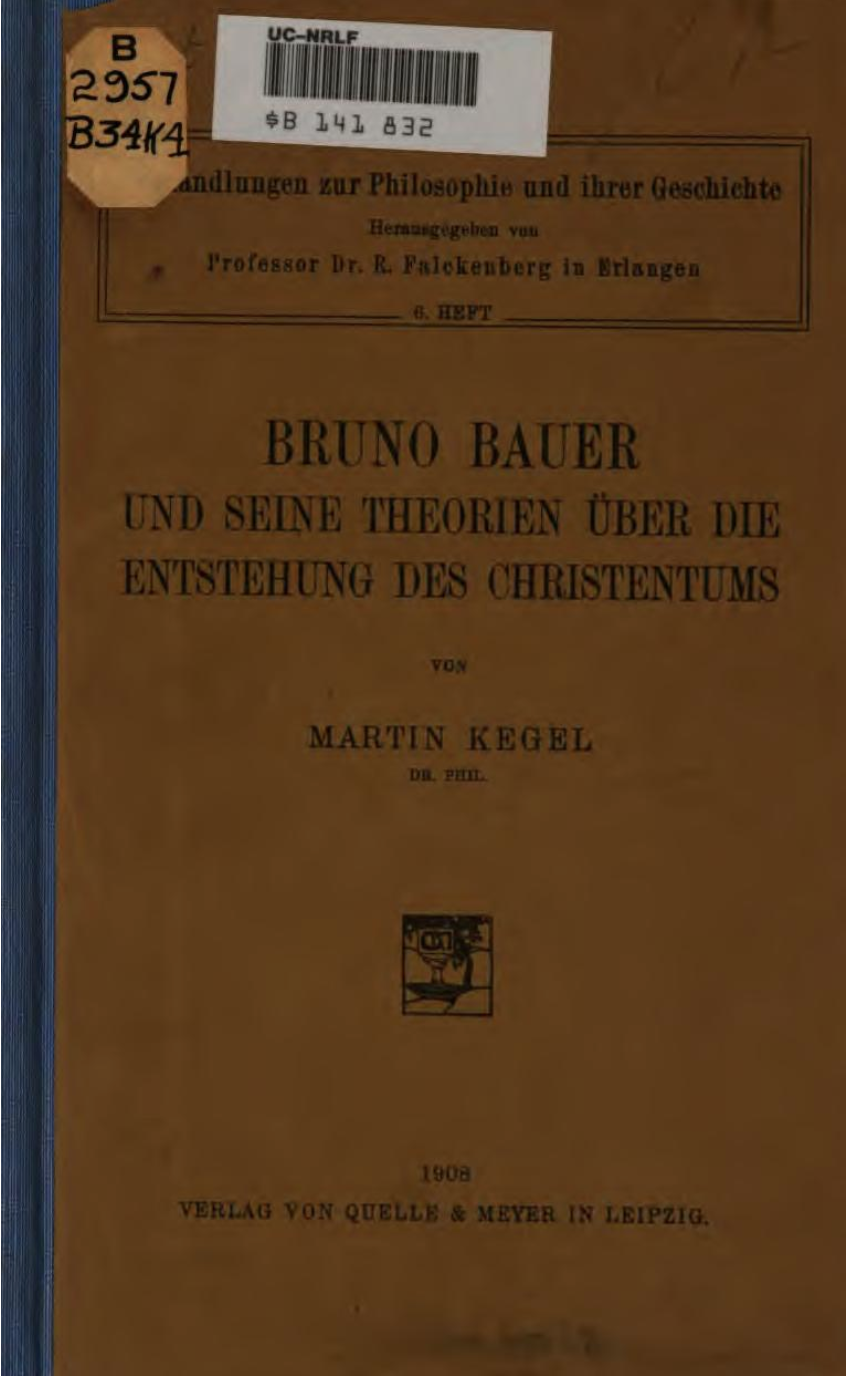 With the assistance of machine translation tools I have been making some of Bruno Bauer’s key works on New Testament criticism available in English. This page links to BB’s chapters on his Criticism of the Gospel of John, published in 1840. I will continue to add more chapters as (a) attempt to proof-read translations for accuracy and readability and (b) format them for online posting here. Unfortunately I have not been able to render all of BB’s words with the clarity I would like, especially his more philosophical and theoretical discussions. But there is still much more that is clear for those who are interested.
With the assistance of machine translation tools I have been making some of Bruno Bauer’s key works on New Testament criticism available in English. This page links to BB’s chapters on his Criticism of the Gospel of John, published in 1840. I will continue to add more chapters as (a) attempt to proof-read translations for accuracy and readability and (b) format them for online posting here. Unfortunately I have not been able to render all of BB’s words with the clarity I would like, especially his more philosophical and theoretical discussions. But there is still much more that is clear for those who are interested.
The page numbers correspond paragraph by paragraph to the published online text on Google Books so if you want to compare what I have posted here with the German original it should not be too difficult to do so.
The German text I have used is located on Google Books. Consider my effort a draft awaiting someone more knowledgeable of Bauer’s thought and the German language to refine into a more respectable translation.
Criticism of the Gospel of John
-
- Title page and preface
- §1 Prologue (1:1-18)
- §2 The Circle of Expectation (1:19-52)
- §3 The Miracle at Cana (2:3-11)
- §4 The Cleansing of the Temple and its Justification (2:12-22)
- §5 Jesus and Nicodemus (2:23-3:21)
- §6 Jesus’ Baptism Collides with John’s (3:22-36)
- §7 Jesus in Samaria (4:1-42)
- §8 Jesus as a prophet in a foreign land (4:43-54)
- §9 Rest Stop (– discusses 5:1 and the mechanics of the author of the fourth gospel, but then moves to philosophical discussion of inspiration, historical consciousness and criticism — not an easy read.)
- §10 The first Sabbath violation (5:2-47)
- §11 Feeding the People and the Church (6:1-71)
- §12 Echo of the dispute over the first Sabbath violation (7:1-53)
- §13 The adulteress (7:53-8:11)
- §14 Continuation of the dispute about the person of the Lord (8:12-59)
- §15 The second Sabbath violation (9:1-10:21)
- §16 The unity of Jesus with the Father (10:22-39)
- §17 Concluding Remark
- Appendix — The Messianic Expectations of the Samaritans (extension from §7 – Jesus in Samaria. Compare Appendix: The Messianic Expectations of the Jews at the Time of Jesus in Criticism of the Gospels)
BB does not go beyond 10:39 in this volume. He continues discussion of the Gospel of John in Criticism of the Gospels and History of their Origin – in English. The reason for the break is that up to 10:39 the Gospel of John can be analysed for the most part independently of the Synoptic Gospels but in order to investigate the origin of the later chapters comparisons with the Synoptics are essential.
Comments by Martin Kegel on Bauer’s criticism of the Gospel of John
 Comments on the Bruno Bauer’s Criticism of the Gospel of John by Martin Kegel: Bruno Bauer und seine Theorien über die Entstehung des Christentums [= Bruno Bauer and His Theories on the Origin of Christianity]. Quelle & Meyer, 1908.
Comments on the Bruno Bauer’s Criticism of the Gospel of John by Martin Kegel: Bruno Bauer und seine Theorien über die Entstehung des Christentums [= Bruno Bauer and His Theories on the Origin of Christianity]. Quelle & Meyer, 1908.
The plan:
Bauer’s original plan had been to continue his “Critique of the History of Revelation” (Part I) by presenting the historical preconditions of Christianity to the critical examination of the New Testament Revelation. This plan – he says in the preface to his new work on the Gospel of John – of a presentation following the course of history, he has given up and with his new writing has entered a path that will lead more quickly to the goal1). He wanted to proceed in a literary-critical manner and begin his investigation with the latest form of New Testament literature. For, he later said (“Deutsche Jahrbücher” 1842, p. 670): “With the insight into the composition and tendency of the Gospels and their individual sections, the insight into their origin and into the historical basis or ideal meaning of their reports is also given”. He wanted to begin with the latest structure and then penetrate further and further into the early period of the production of New Testament literature and thus come closer and closer to the origins of Christianity itself.
But what was this latest structure? Bauer was certain that it was the Gospel of John. At the beginning of the century, this Gospel had been subjected to sharp attacks2) : the time was preparing itself in which one would no longer draw one’s knowledge of the founder of Christianity from the Gospel of John, as had been the case hitherto, but from the Synoptics alone, the time within which we still stand to some extent. Bauer helped to bring about this time; his work was intended to show that the fourth Gospel was not suitable to inform us about the origins of Christianity. — p. 25 — all quotations here are translations
Early days:
In his critique of John’s Gospel, Bauer had still admitted a number of important positive propositions with regard to the common view of the origin of Christianity; so in particular he had asserted the existence of Jesus and the revelation that had taken place in him of a power (if not quite transcendent, then at least) reaching beyond “all” humanity. — p. 36
Evolution of thought:
Already in his writing on the Gospel of John (p. V and especially p. 418 ff.) he had come to the conclusion that the history of Jewish consciousness, as it had developed from the conclusion of the canon to the appearance of Jesus, was still an unknown area; but there he had still assumed that the messianic views were widespread at the time of Jesus (p. 277 f.), that above all Jesus found his messianic self-awareness confirmed in the Old Testament (p. 335). There he only gave evidence in a supplement that at the time of Jesus the concept of the Messiah as a concept of reflection was not at all present among the Samaritans, let alone generally widespread . . . — p. 37
History of Jesus or the Community?
But if Mark is of purely literary origin, it is obvious that what Luke and Matthew have more than their source Mark is also only a literary extension without a historical background. And this assumption, Bauer shows, can also be proven: nowhere in them do we find anything factual either, but always only construction! In the Gospels, whose conclusion is John, we have nothing more than a development of Christian self-awareness . . . — p. 40
The writing on the Gospel of John had already caused widespread offence by its content and tone . . . — p. 44
Bauer, as has been shown, had founded the whole edifice of his new theories on the proof that in the Gospel of John we have before us a unified work of reflection. From here he advanced to the assertion of the artistic structure of the Gospel of Mark and came to the conclusion: the story could not have proceeded in this way, so the Gospels do not report real facts to us, but they only give us views of the community. — p. 58